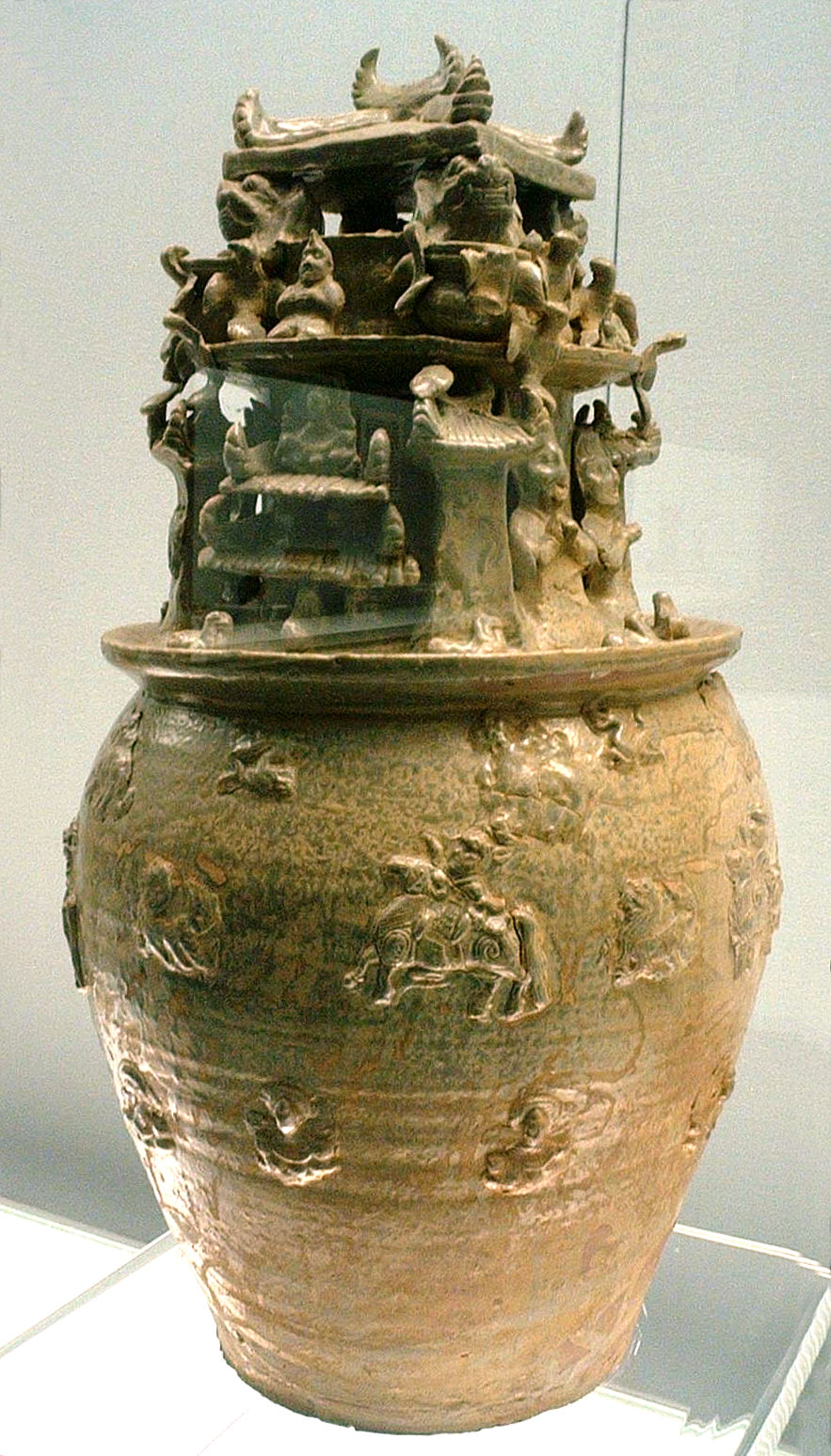Hunping on:
[Wikipedia]
[Google]
[Amazon]

 The ''hunping'' (), translated as soul jar or soul vase, is a type of ceramic funerary urn often found in the tombs of the
The ''hunping'' (), translated as soul jar or soul vase, is a type of ceramic funerary urn often found in the tombs of the
(The Metropolitan Museum of Art) Since the last decades of the Han Dynasty, the top of ''hunping'' vessels started to be decorated with miniature sculptures of men, animals, birds, etc. Gradually, sculptural compositions became more elaborate, including images of entire buildings. It is due to an early- Jin Dynasty ''hunping'', dating to 272, that an early example of a tortoise-born stele is known to us.
A Handbook of Chinese Ceramics
from The Metropolitan Museum of Art Chinese pottery Death customs Jin dynasty (266–420) Pottery shapes
 The ''hunping'' (), translated as soul jar or soul vase, is a type of ceramic funerary urn often found in the tombs of the
The ''hunping'' (), translated as soul jar or soul vase, is a type of ceramic funerary urn often found in the tombs of the Han dynasty
The Han dynasty (, ; ) was an imperial dynasty of China (202 BC – 9 AD, 25–220 AD), established by Liu Bang (Emperor Gao) and ruled by the House of Liu. The dynasty was preceded by the short-lived Qin dynasty (221–207 BC) and a warr ...
and especially the Six Dynasties
Six Dynasties (; 220–589 or 222–589) is a collective term for six Han-ruled Chinese dynasties that existed from the early 3rd century AD to the late 6th century AD. The Six Dynasties period overlapped with the era of the Sixteen Kingdoms ...
periods of early imperial China. It was characteristic of the Jiangnan
Jiangnan or Jiang Nan (; formerly romanized Kiang-nan, literally "South of the River" meaning "South of the Yangtze") is a geographic area in China referring to lands immediately to the south of the lower reaches of the Yangtze River, incl ...
region in modern southern Jiangsu
Jiangsu (; ; pinyin: Jiāngsū, alternatively romanized as Kiangsu or Chiangsu) is an eastern coastal province of the People's Republic of China. It is one of the leading provinces in finance, education, technology, and tourism, with its ca ...
and Zhejiang
Zhejiang ( or , ; , Chinese postal romanization, also romanized as Chekiang) is an East China, eastern, coastal Provinces of China, province of the People's Republic of China. Its capital and largest city is Hangzhou, and other notable citie ...
provinces.
The purpose of a ''hunping'' is somewhat enigmatic, but archaeologists suggest that they may have been used as containers for fruit accompanying the deceased into the afterlife. According to the Metropolitan Museum of Art
The Metropolitan Museum of Art of New York City, colloquially "the Met", is the largest art museum in the Americas. Its permanent collection contains over two million works, divided among 17 curatorial departments. The main building at 1000 ...
, the ancients may have hoped that the soul of the deceased would eventually reside in the vessel.Funerary urn (''hunping''), Western Jin dynasty (265–317), ca. 250–300. China. Earthenware with green glaze. (1992.165.21)(The Metropolitan Museum of Art) Since the last decades of the Han Dynasty, the top of ''hunping'' vessels started to be decorated with miniature sculptures of men, animals, birds, etc. Gradually, sculptural compositions became more elaborate, including images of entire buildings. It is due to an early- Jin Dynasty ''hunping'', dating to 272, that an early example of a tortoise-born stele is known to us.
See also
*Haniwa
The are terracotta clay figures that were made for ritual use and buried with the dead as funerary objects during the Kofun period (3rd to 6th centuries AD) of the history of Japan. ''Haniwa'' were created according to the ''wazumi'' techniq ...
Notes
{{ReflistExternal links
A Handbook of Chinese Ceramics
from The Metropolitan Museum of Art Chinese pottery Death customs Jin dynasty (266–420) Pottery shapes